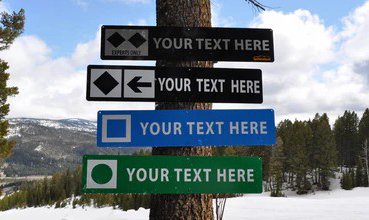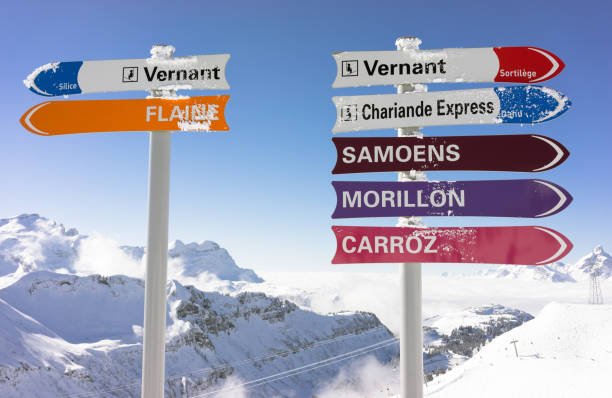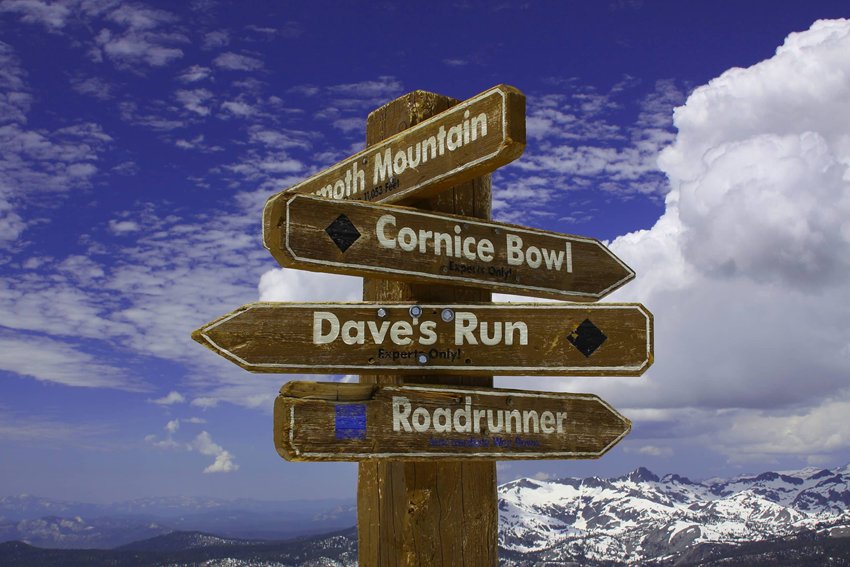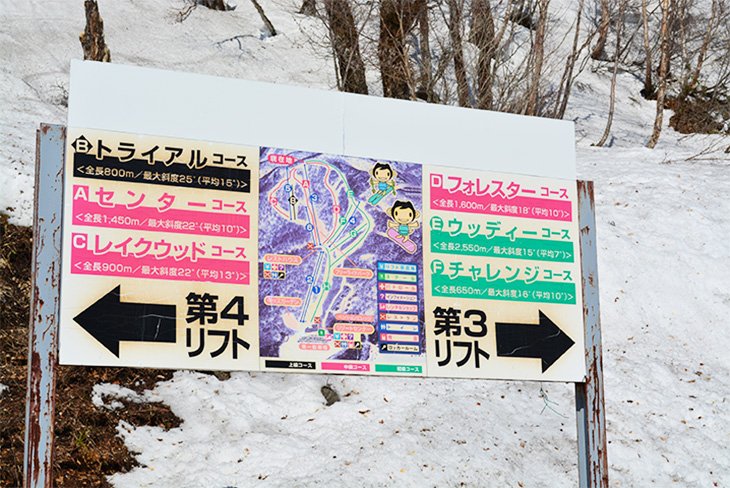Fodsports FX 60C vs FX30C Pro: What's new techs are the FX 60C bringing to us? Fodsports is a brand worth-mention for helmet communication and video recording. This brand has established itself as a key player with its innovative Bluetooth camera intercom systems. Recently, Fodsports has released a new camera intercom, the FX 60C. How […]

What are the ratings for ski slopes? (Full Difficulty Chart)
What are the ratings for ski slopes that are suitable for you? Have you learned about it before you start skiing?
Skiing is a popular winter sport that attracts millions of enthusiasts worldwide. Whether you're a beginner or a seasoned pro, understanding ski slope ratings is crucial for a safe and enjoyable experience on the mountain. This guide will delve into the various aspects of ski slope ratings and tips while you are skiing on the slopes. Read and remember this blog, it will help you navigate the slopes with confidence.
Table of Contents
1. What Are Ski Slope Ratings?

commonly seen ski slope ratings
Ski slope ratings are a system used to classify the difficulty levels of ski runs.
It is important to note that ski slopes are measured in percentages, not degrees. For example, 50% means 45 degrees, because 45 degrees is half of a vertical angle of 90 degrees.
So, when you head to a 25% slope, you can calculate that the slope is 22.5 degrees.
These ratings help skiers choose trails that match their skill level. Choosing the suitable slope rate ensures your skiing safety and maximizes your enjoyment.
The specific symbols and colors may vary slightly from country to country. But, the general system is fairly consistent worldwide.
2. Different Ratings of Ski Slopes in Different Areas
In fact, there is no international standard ski rating currently.
Therefore, the ski rating is different in ski resorts in different countries and regions.
You can simply understand that these grade differences are determined relative to other ski slopes in their resort.
Therefore, even if two different resorts have green ski-rating slopes, don't assume that the difficulty of these two ski slopes is the same. It can only be said that their difficulty is similar.
Generally, there are four main kinds of skiing rates according to area.
2.1 Ski slope difficulty ratings in Europe, excluding Scandinavia

Signs for different ski lifts and local villages in the Grand Massif ski area in the French Alps.(Source: iStock)
This set of ski trail ratings is mainly used in European countries including France, Poland, Spain, Bulgaria, the United Kingdom and others.
| Ski Slopes and Symbol | Difficulty Level | Description |
|---|---|---|
Green |
Learning/beginner | These are usually places where there are no marked paths. They are generally large, open areas with gentle slopes at the bottom of the ski resort or between the main paths. |
Blue |
Easy | These sections are usually no more than 25% grade (but there are some short, wide sections with slightly steeper grades). And most are groomed. |
Red |
Intermediate | This level usually has a slope of no more than 40%, and the trails are steeper or narrower than the Blue Slopes. The trails are usually groomed unless the trail is too narrow. |
Black |
Advanced or expert | Black slopes are usually steep, may or may not be groomed. Black slopes in Austria, Italy and Switzerland are almost always groomed. In France, most black slopes are not groomed, and the boundary between red and black slopes tends to be higher. |
Orange |
Extremely difficult | Orange slopes are only found in Austria, Switzerland and some other regions. They are usually used to mark more difficult ski slopes than black. |
Yellow |
Skiroute, itinéraire, or freerideroute |
These are usually ungroomed and unpatrolled ski slopes that are actually cross-country skiing. However, these slopes are marked and have avalanche protection measures. In Austria, there are also ski slopes that are usually marked with orange squares. It is also common to mark these slopes with red diamonds or red diamonds with black edges. The latter is more difficult. |
Orange square |
||
Red diamond |
||
Red diamond with black edges |
You may find that the European Alpine skiing slope classification is not strictly based on slope angle. Indeed, this is different from the strict classification based on slope angle in North America.
In Europe, a slope may be classified as more difficult if it is shallow but requires more skiing ability. Some slopes may also be classified as more difficult if they are shallow but narrow.
2.2 Scandinavia Ski Slope Rating System
In the Scandinavian area, like Norway, Sweden, and Finland, they have a different ski slope rating system. But do not worry, their color and shapes are almost the same as European areas. They generally divide the ski slope rate according to the slope angle.
| Ski Slopes and Symbol | Difficulty Level | Description |
|---|---|---|
Green circle |
Very easy | Slopes that up to 9° (16%). |
Blue square |
Easy | Slopes that up to 15° (27%). |
Red rectangle |
Moderately difficult | Slopes that up to 25° (47%). |
Black diamond |
Difficult | Slopes that are over 25° (47%). Some extremely difficult areas also use the triple black diamond symbol. |
Double black diamond |
Very difficult |
2.3 North America, New Zealand, Australia Ski Slope Rating System

ski slope rating board in America
The North America, New Zealand and Australia areas use a color-shape ski slope rating system.
| Ski Slopes and Symbol | Difficulty Level | Description |
|---|---|---|
Green circle |
Easiest | This type of ski slope has a slope rating from 6% to 25% and is also the easiest slope. Most of them are wide and groomed. |
Blue square |
Intermediate | Blue square ski slopes are classified as moderately difficult. Generally, slopes of this difficulty are well groomed. Their slopes range from 25% to 40%. This is also the grade of most slopes in most ski resorts. |
Black diamond |
Advanced Difficult |
Most Black diamond ski slopes are very steep, with a grade of more than 40%. Therefore, they are among the most difficult trails. These trails may or may not be groomed. |
Double black diamond |
Very Difficult | These trails are more challenging than black diamond trails because of the steeper slopes. So they are more suitable for experienced skiers only. Be aware of hazards such as narrow trails, exposure to wind, and obstacles such as steep slopes or trees. |
| Triple black diamond |
Expert Only | These trails are more difficult than the double black diamond trails and are only for the most experienced skiers. There will be narrow trails, exposure to wind, and obstacles such as steep slopes or trees. The slopes of trails at this level are steeper than the double black diamond trails, and some can even reach 90%. Therefore, please use good equipment even for the most experienced skiers. |
Variations |
Various | The use of a diamond and a square to indicate a grade between the blue square and the black diamond is commonly known as "blue-black". Some popular resorts in the United States use a combination of blue and black symbols to indicate intermediate to advanced trails. Other ski trails use other combinations of graphics to indicate intermediate to difficult trails. For example, orange diamonds, green circles within blue squares, and black diamonds within blue squares. |
Terrain parks |
Various | An orange rectangle with rounded corners usually represents a terrain park. Skiers can pass through a terrain park to get down the mountain without having to worry about hitting any obstacles. Typically, the difficulty of this area goes beyond the traditional snow hills and features a variety of jumps, half-pipes, and other special "extreme" sports obstacles. Of course, different levels of terrain parks have different difficulties. For example, a black diamond or double black diamond terrain park will have larger and more challenging obstacles than a blue square rated park. |
2.4 Japan Ski Slope Rating System

Japan ski slope rating sign
The ski slope rating in Japan is simpler, just use color systems.
| Ski Slopes and Symbol | Difficulty Level | Description |
|---|---|---|
Green circle |
Beginner | Simpler ski slopes, are suitable for beginners. Most of the green circle slopes are located near the foot of the mountain. Some of them follow a zigzag route down from the top of the mountain. |
Red circle |
Intermediate | Most Japanese ski slopes are rated red circle in difficulty. |
Black circle |
Expert | These are the steepest and most difficult slopes at the resort and are classified as expert slopes. The difficulty of these slopes compared to similar slopes at other ski resorts depends largely on the target audience. |
What's more, the ski slope rating system in Japan is somewhat confusing.
Some ski resorts in Japan, which primarily cater to foreigners, use the North American or European color coding system.
While there are many ski resorts in Japan, most are small. If you compare Japan's slope classification to "equivalent" slopes in Europe or North America directly, you may be misled.
Which Ski Slope Rating Should I Get?
The above have listed the ski slope rates in detail. So before you start skiing, choose the one that is most suitable for you.
Know the basic ratings of ski slopes
- If you are a beginner skier, just go to the Green areas! Learn about the basic techniques and gain confidence first.
- For intermediate skiers who have obtained the basic ski skills, then you can consider going to the Blue Square slopes. They are also good for improving your skills and exploring more challenging runs.
- More advanced skiers can consider the Black diamond slopes. Only attempt if you have strong skills and experience.
- The Double Black Diamond slopes are for experts only. They are the most challenging slopes, with steep drops, obstacles, and unpredictable conditions.
Confirm with the instructor in the ski park
Different ski resorts have different terrains. Even two slopes with the same slope rate can give you different skiing experiences. Therefore, when you go to a new ski resort, it is best to ask the staff or instructor at the ski resort about the resort's conditions. They are more familiar with their own terrain.
Go with the skier who is more experienced than you
For beginner skiers, it is best to find an experienced skier to go with you. Some ski resorts have coaches who can give you guidance, which is a better choice. Of course, if you have a friend who is an experienced skier, it is even better to let him take you.
During the skiing, they can share skiing tips with you, guide you through obstacles and pay attention to the terrain. They can also give you timely feedback on your skiing posture or other details that need to be improved.
You can choose to use a ski helmet communication system to improve the fluency and convenience of your communication. Install it on your ski helmet and connect it with your companions to communicate. Compared with the need to communicate through shouting or gestures, normal verbal communication will give you a better skiing experience.
In addition, you can also connect it to your mobile phone via Bluetooth and connect it to other companions' walkie-talkies at the same time to achieve more convenient communication. Then you will be able to listen to music while skiing, and also can intercom with your partners.
Next, focus on skiing, follow your leader, and run on the ski resort together!
Use Ski Intercom for Communication on the Ski Slopes
Be careful
Safety is key on the ski slopes. So, it is better to stick to slopes that match your skill level.
What's more, pay attention to the weather and slope conditions while you are planning to ski.
Consider choosing the less challenging slopes if you are not experienced or if your body is not at the best status.
The more steep slopes are always there, so don't worry. You can conquer it the next time when you have mastered the necessary skills.
Conclusion
Ski slope ratings are an essential tool for all skiers. They help you choose the right trails, ensuring a safe and enjoyable skiing experience.
Whether you're just starting or tackling expert runs, knowing these ratings will enhance your time on the slopes.
Besides, consider the weather conditions and personal safety when planning your ski adventures.
Now, I believe you have a comprehensive knowledge of what are the ratings for ski slopes. They will help you have more fun and a better experience on your next ski journey.

Motorcycle mechanic, writer. Interested in motorcycle gear for years. Like to stay up to date with the newest products and techniques of the motorcycle.
The Fodsports FX 60C is leading a revolution in the Bluetooth camera intercoms market. This 2025 newest intercom with camera by Fodsports is designed to enhance your riding experience. This device comes with advanced features like Bluetooth 5.4, 4K HD recording, 10-way intercom, and plenty more. So it is clear that this device seamlessly blends […]
For motorcycle riding safety, effective stopping rocks because it has an influence on how fast you stop how stable you are, and how much control you get. Figuring out when and how to use the front and back brakes can really bump up your riding game and keep you safe. This guide is gonna show […]
As the electric vehicle Revolution accelerates the world of motorcycles, is no exception To be a landmark year for electric motorcycles with Cutting Edge. Technology, performance, and design advancements reshape the market. Electric motorcycles. Now, offers impressive, power, extended range, and Sleek designs. Whatever you need, the options in 2025 are more diverse and exciting […]
Motorcycle enthusiasts are a dedicated group. They enjoy the sense of liberation on the open highway, the excitement of riding, and the opportunity to display their beloved two-wheeled machines. But in today’s world, there’s a new debate revving up in the motorcycle community: gas vs. electric motorcycles. If you're an experienced rider or a beginner […]
Shopping for a motorcycle enthusiast can be tricky, especially if you’re not familiar with the gear and gadgets that make riding more enjoyable. Whether it’s the thrill of the ride, the joy of the open road, or the love for motorcycles themselves, finding the perfect Christmas gift can feel overwhelming. Here is a guide of […]

